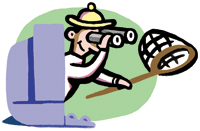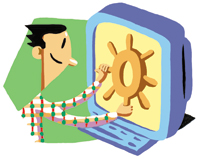
When a client asks me about how to optimize his or her site, I often reply that it’s a lot like eating an elephant: Tear off one bite a time. For most retailers, a bloated large-scale redesign rarely makes as much sense as a series of cost-effective surgical strikes. But where to begin?
Your top landing pages are a smart place to start your optimization work. Consult your site analytics reports and identify the entry pages that most often introduce your brand to prospective customers. At a glance, does each page quickly provide an easily scannable answer to these three questions?
-
What can I do here?
-
Why would I do it here and not somewhere else?
-
How do I start?
Your pages passed that test? Good. In that case, you’re probably aware of the observation by master marketer Seth Godin’s that every commercial Web page is in fact an offer page, and that each page’s central offer is always one of three things:
- Buy something.
- Give me some information.
- Click further into my site.
Is there a difference between optimizing for paid search vs. natural search?
Let’s zoom in on those landing pages typically most important to your online acquisition efforts: landing pages for your search campaigns.
Recently I participated in an online discussion in which I was asked about the key differences between optimizing pages for paid search vs. natural search. It’s a great question, and one that I think reflects a fundamental tension that every site owner must address.
Successful paid-search landing pages are always designed to persuade human visitors to take action. (Which actions? See Godin’s three offers above.)
But too often, pages designed for success in natural search marginalize the human user and place too much emphasis on courting the search engine spiders that crawl your site.
It’s easy to recognize a page that’s become a battleground for human vs. spider search: a well-designed page sadly cluttered with link-laden repetitive copy written to bait a search ‘bot, instead of satisfying a customer.
This is a short-term, misguided strategy. Search-engine spiders exist to serve people’s needs. I’ve never heard of a search spider showing up at a site to solve a problem, let alone pull out the plastic to purchase goods or services.
To build a search-engine-friendly site, you need to understand what the engines evaluate when they review a page. But before keyword stuffing or adopting a myopic focus on tagging your pages for spider appeal, adopt this fundamental strategy:
Build your site for your human users first, the search engines second.
Ultimately, search-engine spiders and human prospects have similar tastes — both will reward you for relevant content, properly formatted.
When you put the user first and spiders second, you see that many of the same high-level principles guide you in creating pages for both.
a. Focus Choose just one or two main ideas for each of your pages; target just one or two keywords for each of your pages; target just a few keywords for each of your title tags, etc.
b. Prominence Say the most important things first: the most important ideas at the beginning of a page; the most important keywords at the beginning of a page and at the beginning of a title tag.
c. Specificity Help both the humans and spiders scanning your pages by avoiding vague phrases like “click here” and headlines that are clever but convey no specific (and keyword-rich) info.
d. Speed Humans hate slow pages. Spiders won’t stick around either.

Let’s take a more detailed look at how you can take advantage of some these concepts when optimizing pages for your own campaigns. Based on PPC work with more than 100 retailers, The Rimm-Kaufman Group offers these eight tips for effective paid-search landing pages.
- Inspire trust at first blush
Your user starts forming opinions fast. In January 2006, a widely publicized study reported that many visitors decide whether or not they like a Website within 50 milliseconds, less than the time it takes to blink. It’s clear that first impressions count! The quality of your page’s visual design has great influence on these first impressions, but this is more than a beauty contest: Scannable guarantees, third-party endorsements and customer testimonials all help build credibility.
- Provide a “why” to buy
Remember, your prospect needs a reason to take action on your site, instead of on a competitor’s. What differentiates you from the retailer residing a click away. And how quickly and persuasively can you make your case? The more skilled you are at making your unique selling proposition transparent on the page, the greater your advantage. (For more on making your site’s USP come to life, see “Give site visitors a why-to-buy” in the October issue.)
- Be normal — follow Web conventions
Your prospect spends 99% of her time on Websites that aren’t yours. With that in mind, don’t make your user learn how to shop your site. Instead, rely on familiar design conventions to remove distraction and help your shopper focus on your product and offer.
- Always match the depth of your site’s landing page to the depth of your user’s search
Try to meet your user’s precise expectations. If the search phrase is “short-sleeve sport shirts,” taking the user to the “sports shirts” page is casting too wide a net, and taking him to the “Ralph Lauren Short Sleeve sport shirts” page is going too narrow, too soon.
(Extra tip: Look at the search strings users are entering to reach your pages. If everything selling from the bathing suit page is a tankini, it’s time to design a tankini page.)
- Provide ease of navigation up, down, and sideways
Despite your best efforts to match landing page to search term, your user still needs clear signage to easily explore related subsections and subcategories — to discover how your site is organized.
- Provide decision aids
When your landing page is a product category page, be sure to provide the shopping tools and decision aids that help your shoppers choose. To serve more than one kind of shopper, offer both left-brain tools, such as guided navigation, and right-brain decision aids, like recommended or featured products. While these features are of obvious importance on a category page, it’s also smart to at least link to them when your landing page is an individual item page.
- Add relevant cross-sell to increase average order size
There are always two ways to increase dollars per visitor: Convert more visitors or increase average order size. Cover both bases: When your landing page is an individual item page, offer related items and accessories to increase order value.
- Blaze a clear path to conversion
Sure it sounds obvious, but is it clear to the visitors who arrive on your landing page exactly where they need to click to move forward in the buying process? Your landing page design must offer an uncluttered, clearly labeled call to action.
Afinal note: No page is an island. We began our discussion by suggesting that the best way to start optimizing your site is to “chunk” your work. Your next challenge?
Whether we’re talking paid search, natural search or both, a collection of “killer” landing pages does not a coherent shopping experience create. Optimize your landing pages, but then go deeper. Shop your own online store, and tune the individual features and overall flow that make for an effective Website. l
Larry Becker is principal, Website effectiveness, at the Rimm-Kaufman Group (www.rimmkaufman.com.), an online marketing agency offering Website consulting and paid-search services.